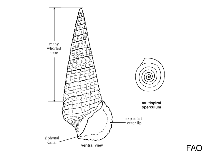Pirenella alata (Philippi, 1849)
Google image | No image available for this species;
drawing shows typical species in Potamididae.
Classification / Names Populärnamn | synonymer | CoL | ITIS | WoRMS
Gastropoda | Not assigned | Potamididae
Environment: milieu / climate zone / djupintervall / distribution range Ekologi
. Tropical
Distribution Länder | FAO områden | Ekosystem | Förekomster | Utplanteringar
Western Pacific.
Length at first maturity / Size / Weight / Age
Könsmognad: Lm ? range ? - ? cm
Short description Morfologi
Life cycle and mating behavior Könsmognad | Reproduktion | Lek | Eggs | Fecundity | Larvae
Main reference
referenser | Koordinator | Medarbetare
Poppe, G.T. 2008 Philippine marine mollusks. Vol. 1 (Gastropoda - Part 1). ConchBooks. 759 p. (Ref. 86518)
IUCN Red List Status
(Ref. 130435: Version 2025-1)
CITES status (Ref. 108899)
CMS (Ref. 116361)
Threat to humans
Human uses
| FishSource |
Verktyg
Ytterligare information
Födosammansättning
Födointag
Predatorer
Max. ages / sizes
Length-weight rel.
Length-length rel.
Length-frequencies
Mass conversion
Abundans
Internet-källor
BHL | BOLD Systems | CISTI | DiscoverLife | FAO(Publication : search) | Fishipedia | GenBank (genome, nucleotide) | GloBI | Gomexsi | Google Books | Google Scholar | Google | PubMed | Tree of Life | Wikipedia (Go, sök) | Zoological Record



